History of Sevilla:
The city’s early origins go back to the first millennium B.C., but its historical importance began with the founding of the first Phoenecian colonies and the Kingdow of Tartassos. Much later, the strategic location of Hispalis, as it was the known, consolidated its position as one of the chief cities of the Roman province of Betis, becoming a district capital and an area of economic influence which was to grow Bishop of the city and one of the most brilliant personalities of his time.
In 711 A.D. the city was conquered by Muslim forces from North Africa and in the 11th century Sevilla (Isbiliya in Arabic), became the greatest of the independent kingdoms of Taifas of Al-Andalus. It is during this period that the building of the Alcazar took place (913 A.D.) and the city walls were extended. From the middle of the 12th to the middle of the 13th centuries it was the capital of the Almohades, who in 1248 surrendered the city to Fernando III, a Christian monarch who imposed reforms according to the policies of the time.
The discovery of America brought an era of great splendor to Seville with the granting in 1503 of the monopoly in commercial traffic with the Indies. In this period, there took place the wedding of the Emperor Carlos V in the Alcazar as well as the building of the Cathedral and many churches, convents and palaces, giving rise to the saying “he who has not seen Seville has never seen a marvel”. The city enjoyed a swift cultural and creative expansion which attracted some of the mos important intellectual figures of the time besides artists such Murillo, Velazquez, Zurbarán, etc.
The plague epidemic in 1649 carried off half the city’s inhabitants, marking the beginning of a period of decline not improved by the river growing progressively less navigable, for which reasons in 1680 the privilege of commerce with the Indies was lost to Cadiz.
The city’s slow recovery was set back by the War of Independence 18th century, during which it was subjected to repeated attacks and plundering, and it was not until the early Twentieth Century, when the Iberian-American Exposition of 1929 brought about an exuberant urban renovation, that it was finally on its path to a bright future. In 1982 Seville became the capital of the Autonomous Community of Andalucia and in 1992 visitors to the Universal Exposition from the whole world over were to fall in love with a beautiful metropolis in which no modern services were lacking.
The province of Seville being the largest in Andalucia with it 14.000 square kilometers, makes it one of the most visited by tourists. The warmth of its people, the shady corners in its ancient cities, the history of its towns and villages, its landscapes, the Easter processions which are the culmination of its popular fervor and last but by no means least, the April Fair of Seville (Feria de Abril) and explosion of popular joy, all these and many others contribute to fix in visitors memories a warm image which they will never forget.
-
SEVILLE, A WONDERFUL CITY
Sevilla is the artistic, cultural, and financial capital of southern Spain. It is the capital of the autonomous community of Andalusia.
If you love Spain you’ll love Sevilla, the essence of Andalucia, a mixture of cultures: Arab, Jewish and Roman.
You can not miss this wonderful city; you have to visit it at least once in a life time. Sevillanos are very friendly people and you’ll quickly discover that having wine in one of their many terraces is a pleasure that words cannot describe.
Moorish Heritage Seville is more than 2,000 years old. The passage of the various civilizations, instrumental in its growth, has left the city a distinct personality, and a large and well-preserved historical center. Although it has a strong medieval, renaissance and baroque heritage, the city received heavy influences from Arabic culture. If you love Art and Architecture, then you have an obligatory date with Sevilla. This impressive city is typically Spanish, and it has one of the most important monumental legacies in the world.
The city keeps the largest Gothic Architectonics treasures of the world: The Cathedral and a large ensemble of monuments, Palaces, Gardens, narrow streets, beautiful plazas with well-kept courtyards “patios” which are necessary to highlight.
-
MAJOR FESTIVALS IN SEVILLE
-
THE 7 CITY SIGHTS OF SEVILLE YOU CAN NOT MISS
SEVILLE CITY SIGHTS
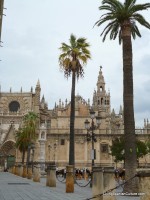 | The Cathedral of Seville stands on the site of the principal mosque of the Almohades in the XII Century, of which building there only remain the Patio of the Oranges and its minaret, that tower known as the Giralda, upon which in 1586 was mounted a body of Renaissance bells. Crowing the whole edifice is the statue of El Giraldillo, the work of Juan Bautista Vázquez which gave the tower its popular name. Construction of the Cathedral commenced in 1401 but in August 1888 one of the pillars in the choir gave way, destroying a great number of stained-glas windows. The Cathedral (Magna Hispaliensis) is considered to be the first Gothic church and the third in Christendom after the Basilica of the Vatican and Saint Paul in London. |
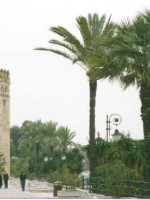 | Torre del Oro. Gold Tower. On the left bank of the Guadalquivir stands the Torre del Oro, seemingly planted there as a sentry over the river. It was built in 1221 as the watchtower of a wall which defended the river landing place. Of Almohade origin, it itswelve sided in plan view, the lantern crowing it being added in the 18th century.
Some Chroniclers favour the view that its name derives from having once being roofed with golden tiles. At present it houses an interesting Naval Museum. |
 | Plaza de España. Built in 1929, its ground plan is semi-circular flanked by two towers.In the square are ceramic benches representing each of the Spanish provinces completed by a pond and a fountain in the centre. |
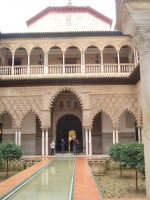 | Real Alcazar. In the year 913 A.D., Abdul Al Rahman III ordered the walls of the Alcázar to be erected. The enclosure was enlarged in the XI century by the Taifa dynasty Abbadies who had adopted it as the site of their court, and in the second half of the XII, kings of the Almohade dynasty extended the defensive walls as far as the river bank, terminating in the Torre del Oro (Tower of Gold). After the conquest of the city by Christian troops it became a Royal residence. Successively enriched by all the kings who passed through it, it was Pedro I who rebuilt part of the Alcázar of the Taifas to form a Palace which is the principal exponent of the Sevillan Mudéjar style. The wedding of Carlos V in the city in 1526 imposed its Renaissance seal upon the Palace, and it was on the occasion of the Latin American Exposition of 1929 that the complete restoration of the building and its gardens was carried out. |
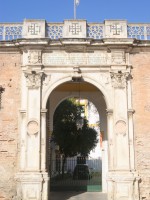 | Casa de Pilatos: this is the best example of a 16th century Sevilla nobleman’s town house. Its popular name comes from the pilgrimage of Don Fadrique Enriquez de Rivera to the Holy Lands, upon his return from which he established within the city a processional way representing the Stations of the Cross which had its starting point, “Jesus before Pontius Pilate”, before his house, and which ended at the Cruz del Campo. Don Fadrique enlarged the site by acquiring neighbouring buildings and gave the building its present appearance in which various styles from the Classical to the Mudéjar intermingle. His successor Per Afán Enríquez carried out further enlargements and in the 19th century the whole building was restored with the addition of some minor works. |
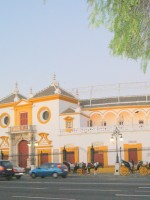 | Plaza de Toros de la Maestranza. La Maestranza Bullring. Its construction was started in 1761, to plans by Vicente San Martín, being finished in 1880. Early in the XX Century Aníbal González restored the building, adding the buildings which house the Museum of Bullfighting and the site of Royal School of Equitation (Real Maestranza de Caballería). Unusually, the ring is oval in shape and of its three access gates the most important is the Prince’s Gate, through which bullfighters who have displayed exceptional skill and valour are carried out on the crowd’s shoulders. Over that gate is situated the Royal Box dating from the middle of the XVIII Century. |
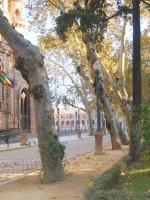 | Maria Luisa's Park. In 1893 The Royal Princess Maria Luisa Fernanda de Borbón y Borbón donated to the city the gardens of the Palace of San Telmo which today bear her name. In 1911, with the Latin-American Exposition of 1929 in mind, preparations were begun for the park to house the Exposition and later to be dedicated as a public park, under the direction of the French designer Jean Claude Forestier. |















